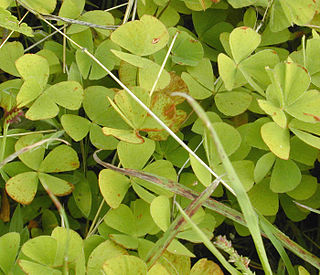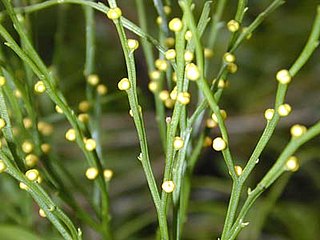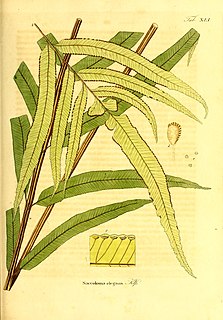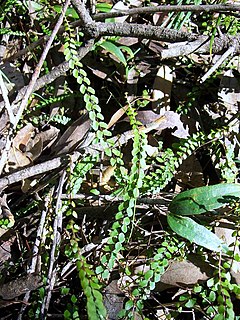
Thelypteridaceae is a family of about 900 species of ferns in the order Polypodiales. In the Pteridophyte Phylogeny Group classification of 2016, it is placed in the suborder Aspleniineae. Alternatively, the family may be submerged in a very broadly defined family Aspleniaceae as the subfamily Thelypteridoideae.

Osmunda is a genus of primarily temperate-zone ferns of family Osmundaceae. Five to ten species have been listed for this genus.

Equisetales is an order of subclass Equisetidae with only one living family, Equisetaceae, containing the genus Equisetum (horsetails).

The order Salviniales is an order of ferns in the class Polypodiopsida.

Marattiaceae is the only family of extant (living) ferns in the order Marattiales. In the Pteridophyte Phylogeny Group classification of 2016, Marattiales is the only order in the subclass Marattiidae. The family has six genera and about 110 species. Many are different in appearance from other ferns, having large fronds and fleshy rootstocks.

Gleicheniales is an order of ferns in the subclass Polypodiidae. The Gleicheniales have records potentially as early as the Carboniferous, but the oldest unambiguous records date to the Permian.

The Dryopteridaceae are a family of leptosporangiate ferns in the order Polypodiales. They are known colloquially as the wood ferns. In the Pteridophyte Phylogeny Group classification of 2016 (PPG I), the family is placed in the suborder Polypodiineae. Alternatively, it may be treated as the subfamily Dryopteridoideae of a very broadly defined family Polypodiaceae sensu lato.

The order Polypodiales encompasses the major lineages of polypod ferns, which comprise more than 80% of today's fern species. They are found in many parts of the world including tropical, semitropical and temperate areas.

Psilotaceae is a family of ferns consisting of two genera, Psilotum and Tmesipteris with about a dozen species. It is the only family in the order Psilotales.

Blechnaceae is a family of ferns in the order Polypodiales, with a cosmopolitan distribution. Its status as a family and the number of genera included have both varied considerably. In the Pteridophyte Phylogeny Group classification of 2016, the family has 24 genera, and excludes genera placed in the separate family Onocleaceae. The family is divided into three subfamilies, including Blechnoideae s.s. Alternatively, the entire family may be treated as the subfamily Blechnoideae s.l. of a very broadly defined family Aspleniaceae, and include genera others place in Onocleaceae.

Pteridaceae is a family of ferns in the order Polypodiales, including some 1150 known species in ca 45 genera, divided over five subfamilies. The family includes four groups of genera that are sometimes recognized as separate families: the adiantoid, cheilanthoid, pteridoid, and hemionitidoid ferns. Relationships among these groups remain unclear, and although some recent genetic analyses of the Pteridales suggest that neither the family Pteridaceae nor the major groups within it are all monophyletic, as yet these analyses are insufficiently comprehensive and robust to provide good support for a revision of the order at the family level.

The Lomariopsidaceae is a family of ferns with a largely tropical distribution. In the Pteridophyte Phylogeny Group classification of 2016 (PPG I), the family is placed in the suborder Polypodiineae of the order Polypodiales. Alternatively, it may be treated as the subfamily Lomariopsidoideae of a very broadly defined family Polypodiaceae sensu lato.

Lindsaeaceae is a pantropical family of ferns in the order Polypodiales. It contains six or seven genera with about 220 known species, some of which also extend into the more temperate regions of eastern Asia, New Zealand, and South America.

Saccolomataceae is a family of ferns in the order Polypodiales. It has been formerly treated as part of the Dennstaedtiaceae, however it has been classified as its own family according to Smith et al. (2006) The genus Saccoloma has been classified to include Orthiopteris, but the phylogeny of the group not yet fully understood. The family includes a dozen known species.

The Dipteridaceae is a family of ferns in the order Gleicheniales of the class Polypodiopsida. They are commonly known as umbrella ferns and contain two genera, Cheiropleuria and Dipteris, with a total of nine species confined to Asia, New Guinea and northern Australia While currently a small family, they were much more abundant in the Mesozoic era, with the oldest fossils being known from the Middle Triassic of Italy, Australia and Argentina. Seven fossil genera are recognised, including Hausmannia, Clathropteris, Dictyophyllum, Thaumatopteris, Camptopteris, and Polyphacelus.
Hemidictyum is a genus of ferns with a single species, Hemidictyum marginatum, commonly known as the marginated half net fern. In the Pteridophyte Phylogeny Group classification of 2016, it is the only genus in the family Hemidictyaceae. Alternatively, the family, along with Aspleniaceae sensu stricto, may be placed in a much more broadly defined family Aspleniaceae as the subfamily Asplenioideae.

Diplaziopsidaceae is a family of ferns in the order Polypodiales. In the Pteridophyte Phylogeny Group classification of 2016 (PPG I), the family is placed in the suborder Aspleniineae, and includes two genera. Alternatively, it may be treated as the subfamily Diplaziopsidoideae of a very broadly defined family Aspleniaceae.

Cheilanthoideae is one of the five subfamilies of the fern family Pteridaceae. The subfamily is thought to be monophyletic, but some of the genera into which it has been divided are not, and the taxonomic status of many of its genera and species remains uncertain, with radically different approaches in use as of December 2019.

Lindsaeineae is a suborder of ferns (Polypodiopsida), order Polypodiales, created by the Pteridophyte Phylogeny Group (2016). It consists of two monogeneric families plus the larger Lindsaeaceae with seven genera, and the suborder contains about 237 species overall. It corresponds to Lindsaeaceae sensu Smith 2016.

















